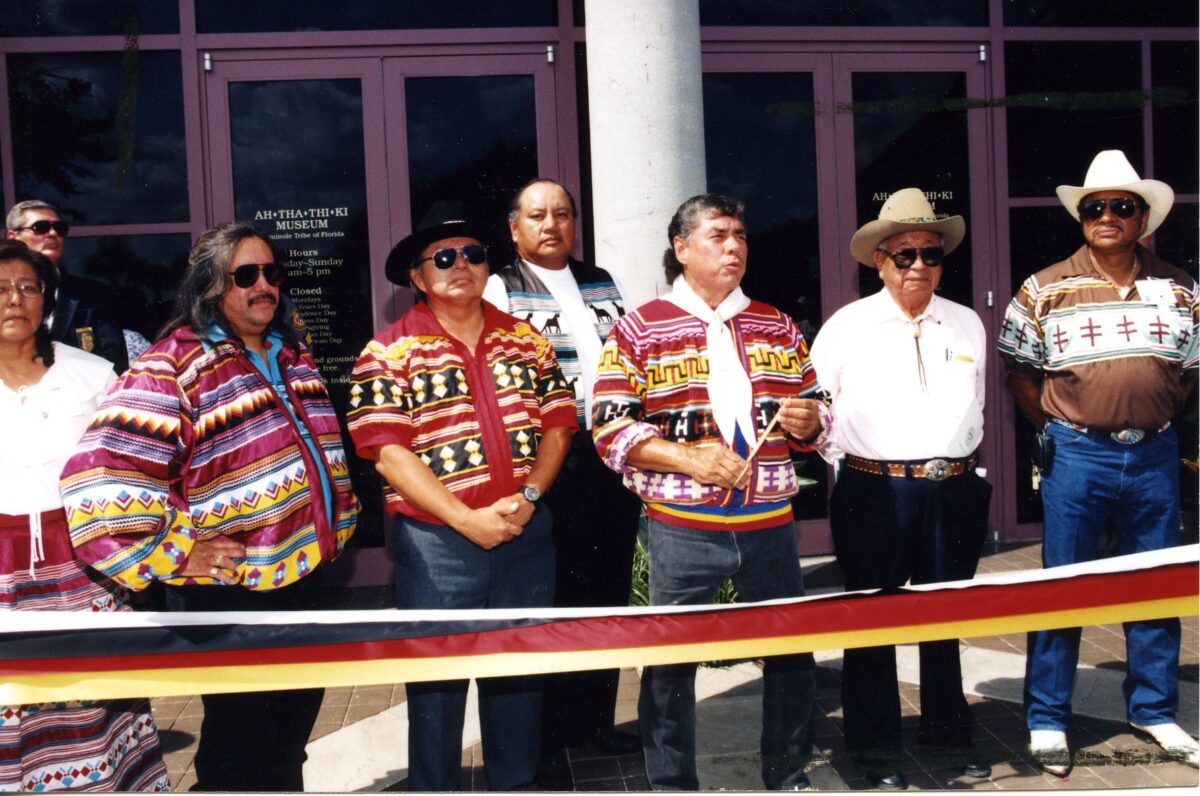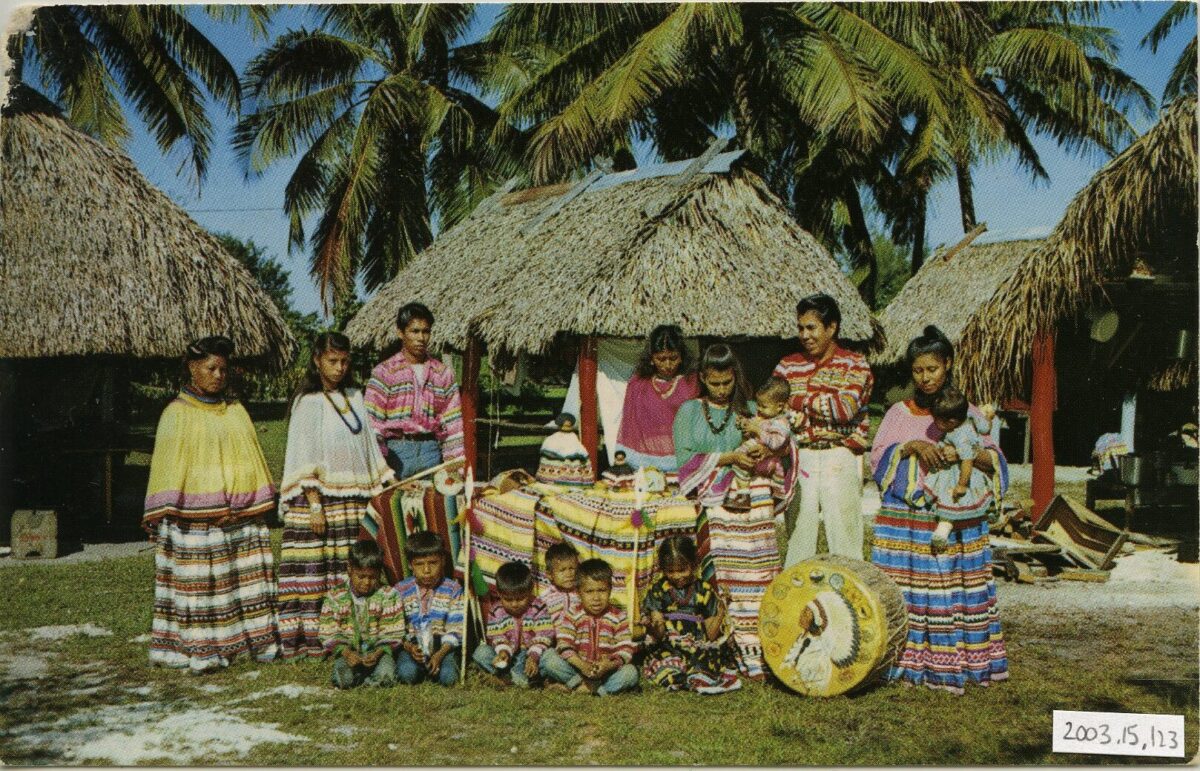
1910s-1920s: Seminole Dolls
Welcome back to the second part of this month’s installment of Decades of Seminole Tourism! Last week, we gave a brief overview of the shifts in Seminole tourism from 1910-1920. As tourist camps, attractions, and Seminole villages began to rise in popularity from 1910-1920, so did Seminole crafts. Sold to tourists for profit, these could include wood carvings, patchwork, and sweetgrass baskets. One popular craft were Seminole dolls. But, these dolls are so much more than just palmetto fiber, cloth, and wood. In many ways, they represent Seminole identity, resistance, and survival. They not only hold an important place in Seminole history, but also Seminole identity and culture. This week, read on to learn all about the evolution of Seminole dolls.
Tourism as Survival
In the last few months, we have discussed how Seminoles became an integral part of tourism in Florida. From tourist camps to alligator shows, there is no part of early Florida tourism without Seminoles. In the late 1910s, many Seminoles began to participate in tourist camps and villages, like those seen at Coppinger’s Tropical Garden and Musa Isle. For more information on the rise of these tourist attractions, look at last week’s blog post here. After the fragmentation of the Everglades, Seminoles turned to tourism as a means of survival. Eventually, after the Tamiami Trail fully opened in 1928, family camps along the Trail would also pop up. At these attractions, Seminoles would sell crafts to tourists. Seminole dolls, wood carvings, sweetgrass baskets, and patchwork would bring much needed income. Seminole dolls became an iconic part of Seminole tourism, and are very much present today.
Throughout their history, the Seminole people have held steadfast to their cultural identity. They are the “unconquered” Seminoles. Adaptability and resilience in the face of struggle are common threads through Seminole history, and the rise of tourism is no exception. Through Seminole dolls, we can see evidence of this resilience as well as a manifestation of this cultural identity. As time progresses and the Seminole relationship with tourism changes, so do these dolls. Initially, Seminole dolls were faceless, featureless cloth dolls made as children’s toys. They held very little cultural identity. Once they became tourist commodities, this changes significantly. The dolls begin to take on cultural features like patchwork, traditional clothing and hairstyles. Born of necessity, they become an iconic representation of Seminole identity and resilience.
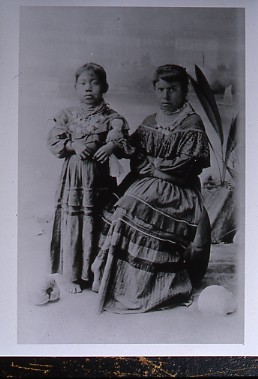
GRP1896.42, 20th Century, ATTK Museum
Early Cloth Dolls
Cloth dolls were the first example of Seminole dolls. These dolls are children’s toys, and not made to sell to tourists. These early cloth dolls are documented between 1882 and 1900. Generally, they wrapped cloth and tied it with strong cord, such as leather. Made of plain or patterned fabrics, these dolls were faceless. Patchwork had not yet emerged. Cloth dolls also did not have capes, or mirror many of the features seen in traditional Seminole clothing like later dolls. In the photo above, a young girl poses with a cloth rag doll in the late 20th century. The doll is featureless and limbless, with a cloth wrapped head.
Wooden Dolls
By the early 1900s, wooden dolls emerged. The maker carved the dolls out of cypress or other soft wood, and nailed the arms to the body. They wear cotton clothes. Artisans carved or painted the face and hair. Men would carve and paint the dolls, and women would make the clothes for them to wear. Wooden dolls are rare. Artisans never produced wooden dolls in mass quantities. In contrast to the earliest cloth dolls, they began to include traditional clothing styles like capes and applique. It is important to note that it is a Seminole cultural taboo to carve a a realistic doll that resembles anyone specific. Stylistically, the features that are seen on Seminole dolls are impressions that are culturally important. So, things like hairstyles, traditional clothing, beads, and other accessories are not exact to a specific person.
The doll below is part of the Ah-Tah-Thi-Ki Museum Collection. The Waggaman family of Kokomo, IN purchased the doll in the early 1900s in the Fort Myers area. It passed down in the Waggaman family until Sue Miller (Waggaman), the great-granddaughter of the original purchasers, donated it back to the Ah-Tah-Thi-Ki Museum. Typical of early dolls, it has no patchwork. It has a two-tiered skirt. The cape and skirt are covered in applique bands. The hair and face are also painted on, and the colorful clothing features maroon, white, red, blue, yellow, and other patterned fabric.
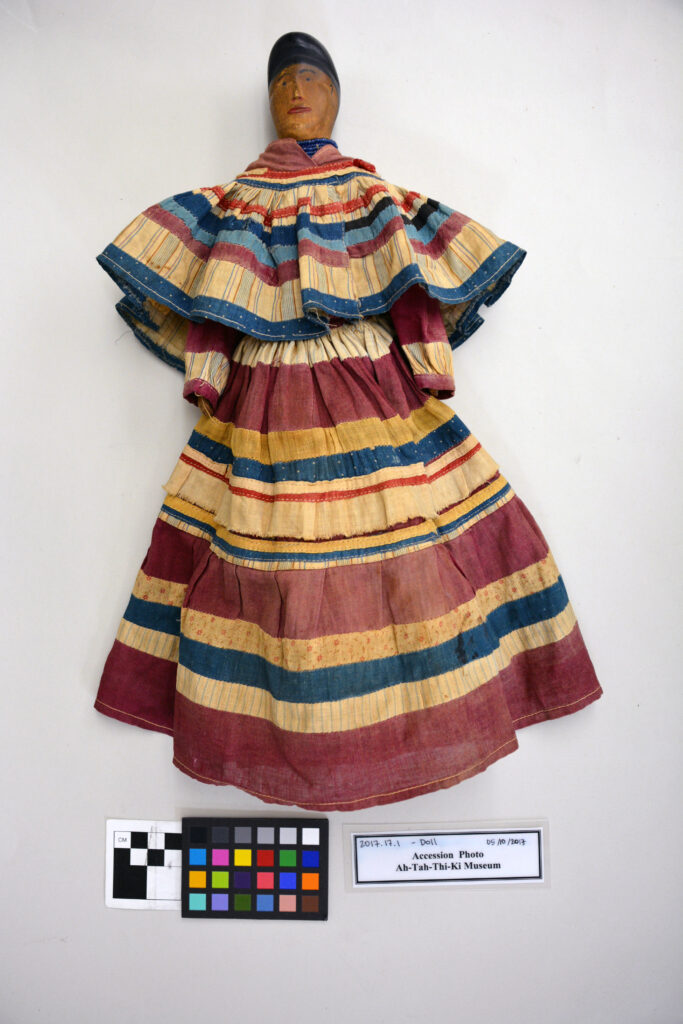
Wooden Doll, 2017.17.1, ATTK Museum Collection
Palmetto Fiber Dolls
Palmetto fiber dolls are the most popular Seminole doll style. In 1980, Florida folklorists interviewed Seminole doll maker Mary B. Billie and her daughter Claudia C. John about making traditional palmetto fiber dolls. An overview of the interview can be found here through the Florida Memory Project. From gathering the palmetto fiber to construction, these dolls are a labor of love. Made with palmetto fiber and stitched with cotton thread, they are often stuffed with cotton or more palmetto fiber. Artisans prefer palmetto fibers to other materials because they better match Seminole skin tones. Female dolls have a single circular head and cone shaped body. Male palmetto fiber dolls have attached limbs, while females do not. Many show traditional styles like high hair, beads, and traditional designs.
Deaconess Harriett Bedell of the Glades Cross Mission helped Seminole dolls explode in the tourist sector. She saw potential in them to foster Seminole economic independence, along with other traditional crafts. In 1937, Bedell arranged for them to be mass produced and sold by the thousands, both in stores and by mail order. Tourists still purchase palmetto fiber dolls today. Some palmetto fiber dolls come in matched pairs, one male and one female. Males wear traditional bigshirts, while women wear long skirts and capes. Also, palmetto fiber dolls sold in the early 20th century started featuring patchwork, in addition to rickrack and appliques. In the photo below, you can see a matched pair. Note the patchwork on the skirt of the female doll, stitched features, beads, and other traditional clothing styles.
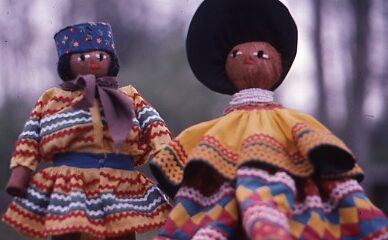
GRP1900.75, ATTK Museum Collection
Doll Head Baskets
One of the most unique Seminole crafts are doll head baskets. A mash up of two iconic Seminole crafts, dolls head baskets are exactly what they sound like. Artisans make Seminole baskets with palmetto fiber and sweetgrass. The baskets feature a doll’s head handle on top. We have talked about the importance and artistry seen in sweetgrass baskets before here and here. Often, the head features beads and traditional hairstyles, as well as sewn-on facial features. Bold colors, intricate coiling in the baskets, and delicate beading make doll head baskets visually stunning and impactful. Like in larger palmetto fiber dolls, traditional styles are mirrored in these doll heads. In addition, layers of beaded necklaces, earrings, and other features are seen in the delicate palmetto fiber heads.
Doll Necklaces, Pin Dolls, and More
Other examples of Seminole dolls are doll necklaces and pin dolls. Wearers attach pin dolls to clothing. Pin dolls are very small, and almost always female. Sometimes they are slightly larger and used to represent children. The first recorded pin doll is from 1941. But, it is not known when they were first made. A newer concept, doll necklaces combine beaded necklaces and dolls. The doll hangs like a pendant at the center of a long-beaded necklace. Other unique dolls may include a mother holding a baby, a woman holding a pestle, or even a man on a horse. The Ah-Tah-Thi-Ki Museum has an extensive collection of historic Seminole dolls. Subsequently, to access the Online Collection, you can start here.
Cultural Survival through Crafts
Seminole dolls, as well as other crafts like sweetgrass baskets and patchwork, are important pieces of Seminole culture and identity. They hold a significant place in Seminole history. In previous blog posts, we have talked about the importance of Seminole maker traditions, and the dangers that come with losing the traditional knowledge. Specifically, the knowledge it takes to making sweetgrass baskets has been in danger of being lost. These crafts are important not only because of the knowledge they represent, but also the reality of their function in Seminole history. They embody Seminole resilience and survival. But, beyond just tourist dollars, dolls and baskets like these share pieces of Seminole culture, history, and experience. Although the Seminole Tribe of Florida has changed, grown, and expanded their role in tourism over the last century, the threads of these crafting traditions, tourist camps, and attractions are still apparent.
In 2003, an event titled “Recapturing Our Identity through Arts and Crafts” took place on the Hollywood Reservation. Elders talked to the younger generation about traditional skills. In a Seminole Tribune article about the event, organizer Vivian Delgado noted that all these crafts were once sold to tourists for survival, and she hoped that younger tribal members would “Remember your culture. remember what it means to be Seminole, and what it means to be Native American.”



